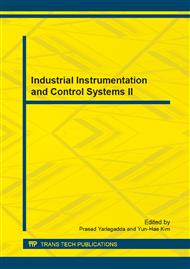p.547
p.551
p.556
p.561
p.566
p.570
p.575
p.581
p.585
The Temperature Prediction in Blast Furnace Base on Fuzzy Least Squares Support Vector Machine
Abstract:
The temperature prediction in blast furnace loses accuracy or Forecasts failure when the temperatures change is at normal levels and obvious. This paper introduces fuzzy membership of samples basing on support vector data description and the fuzzy least squares support vector machine to forecast the blast furnace temperature. Then the simulation was done by using the forecast samples and the model after training by MATLAB. Comparing the simulation results of LS-FSVM with LS-SVM, the model basing on LS-FSVM enhances anti-jamming ability. The accuracy of the temperature prediction in blast furnace promotes significantly when the temperature of blast furnace fluctuates.
Info:
Periodical:
Pages:
566-569
Citation:
Online since:
July 2013
Authors:
Price:
Сopyright:
© 2013 Trans Tech Publications Ltd. All Rights Reserved
Share:
Citation:


